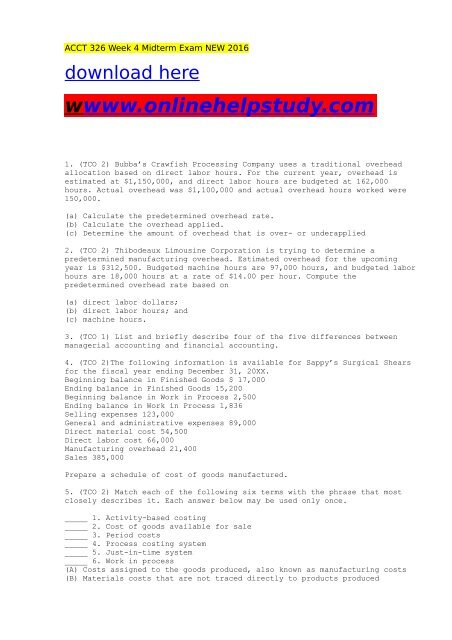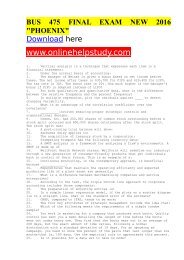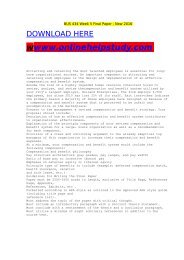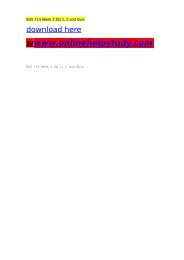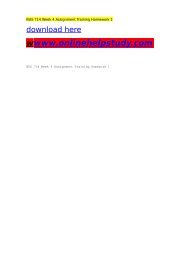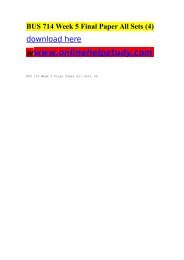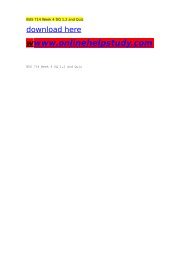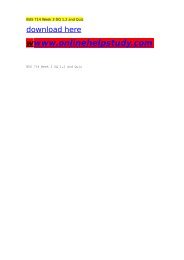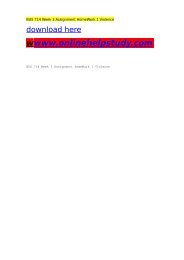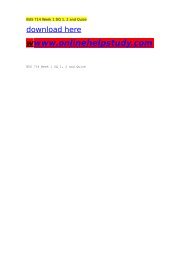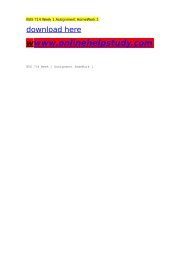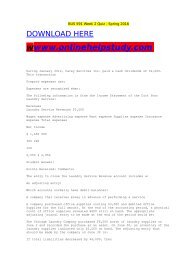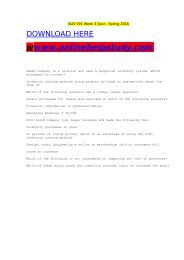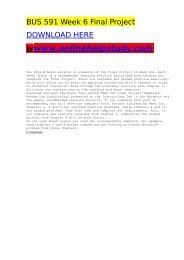ACCT 326 Week 4 Midterm Exam NEW 2016
Create successful ePaper yourself
Turn your PDF publications into a flip-book with our unique Google optimized e-Paper software.
<strong>ACCT</strong> <strong>326</strong> <strong>Week</strong> 4 <strong>Midterm</strong> <strong>Exam</strong> <strong>NEW</strong> <strong>2016</strong><br />
download here<br />
wwww.onlinehelpstudy.com<br />
1. (TCO 2) Bubba’s Crawfish Processing Company uses a traditional overhead<br />
allocation based on direct labor hours. For the current year, overhead is<br />
estimated at $1,150,000, and direct labor hours are budgeted at 162,000<br />
hours. Actual overhead was $1,100,000 and actual overhead hours worked were<br />
150,000.<br />
(a) Calculate the predetermined overhead rate.<br />
(b) Calculate the overhead applied.<br />
(c) Determine the amount of overhead that is over- or underapplied<br />
2. (TCO 2) Thibodeaux Limousine Corporation is trying to determine a<br />
predetermined manufacturing overhead. Estimated overhead for the upcoming<br />
year is $312,500. Budgeted machine hours are 97,000 hours, and budgeted labor<br />
hours are 18,000 hours at a rate of $14.00 per hour. Compute the<br />
predetermined overhead rate based on<br />
(a) direct labor dollars;<br />
(b) direct labor hours; and<br />
(c) machine hours.<br />
3. (TCO 1) List and briefly describe four of the five differences between<br />
managerial accounting and financial accounting.<br />
4. (TCO 2)The following information is available for Sappy’s Surgical Shears<br />
for the fiscal year ending December 31, 20XX.<br />
Beginning balance in Finished Goods $ 17,000<br />
Ending balance in Finished Goods 15,200<br />
Beginning balance in Work in Process 2,500<br />
Ending balance in Work in Process 1,836<br />
Selling expenses 123,000<br />
General and administrative expenses 89,000<br />
Direct material cost 54,500<br />
Direct labor cost 66,000<br />
Manufacturing overhead 21,400<br />
Sales 385,000<br />
Prepare a schedule of cost of goods manufactured.<br />
5. (TCO 2) Match each of the following six terms with the phrase that most<br />
closely describes it. Each answer below may be used only once.<br />
_____ 1. Activity-based costing<br />
_____ 2. Cost of goods available for sale<br />
_____ 3. Period costs<br />
_____ 4. Process costing system<br />
_____ 5. Just-in-time system<br />
_____ 6. Work in process<br />
(A) Costs assigned to the goods produced, also known as manufacturing costs<br />
(B) Materials costs that are not traced directly to products produced
(C) System that seeks to minimize Raw Materials Inventory and Work in Process<br />
Inventory<br />
(D) Cost of items that are completed and transferred from Work in Process<br />
Inventory to Finished Goods Inventory<br />
(E) Costs that are identified with accounting periods rather than with goods<br />
produced<br />
(F) Actual overhead greater than overhead that has been applied to products<br />
(G) Method of assigning overhead costs that uses multiple allocation bases<br />
(H) System that uses job-order sheets to collect costs for each individual<br />
job<br />
(I) Cost of all materials and parts that are directly traced to the items<br />
produced<br />
(J) Beginning balance in the Finished Goods Inventory plus cost of goods<br />
manufactured<br />
(K) Overhead applied to products is greater than the actual overhead costs<br />
incurred<br />
(L) Used by companies that produce large quantities of identical items<br />
(M) Cost of all manufacturing activities other than direct material and<br />
direct labor<br />
(N) Inventory account that contains the cost of goods that are only partially<br />
completed<br />
6. (TCO 2) Far Out Ceramics makes custom macaroni tile and applies job-order<br />
costing. The following information relates to the fiscal year ending December<br />
31, 20XX.<br />
Beginning balance in Raw Materials Inventory $ 12,500<br />
Purchases of raw material 189,000<br />
Ending balance in Raw Materials Inventory 14,300<br />
Beginning balance in Work in Process 24,500<br />
Ending balance in Work in Process 23,100<br />
Direct labor cost 89,700<br />
Manufacturing overhead applied 66,200<br />
Actual manufacturing overhead 66,200<br />
Beginning balance in Finished Goods 28,900<br />
Ending balance in Finished Goods 24,300<br />
Sales 432,000<br />
Selling expenses 120,000<br />
General and administrative expenses 86,000<br />
How much is cost of goods sold?<br />
7. (TCO 2) Match each of the six following terms with the phrase that most<br />
closely describes it. Each answer may be used only once.<br />
_____ 1. Direct costs<br />
_____ 2. Fixed costs<br />
_____ 3. Incremental costs<br />
_____ 4. Enterprise resource planning system<br />
_____ 5. Noncontrollable costs<br />
_____ 6. Opportunity costs<br />
(A) Costs that increase or decrease in total in response to increases or<br />
decreases in the level of business activity<br />
(B) Costs that are directly traceable to a product, activity, or department<br />
(C) Costs that a manager can influence<br />
(D) The difference in costs between decision alternatives<br />
(E) Costs incurred in the past that are not relevant to present decisions<br />
(F) Costs that cannot be influenced by a manager<br />
(G) Financial plans prepared by management accountants<br />
(H) Value of the benefits foregone when one decision alternative is selected<br />
over another<br />
(I) Costs that cannot be directly traced to a product, activity, or<br />
department or are not worth tracing<br />
(J) Costs that do not change in total with changes in the level of business<br />
activity
(K) Systems that prepare a master production system and all of the support<br />
across the company<br />
8. (TCO 3) The marinade department began the period with 125,000 units.<br />
During this period, the department received another 180,000 units from the<br />
prior department, and at the end of the period, 117,000 units remained that<br />
were 13% complete. How much are equivalent units in the marinade department’s<br />
Work In Process Inventory at the end of the period?<br />
9. (TCO 3) The Franc Zeppo Venture manufactures a product that goes through<br />
two processing departments. Information relating to the activity in the first<br />
department during April is given below.<br />
•Work in process, April 1: 50,000 units (80% completed for materials and 60%<br />
completed for conversion)<br />
•Work in process, April 30: 35,000 units (45% completed for materials and 60%<br />
completed for conversion)<br />
The department started 380,000 units into production during the month and<br />
transferred 385,000 completed units to the next department.<br />
Compute the equivalent units of production for the first department for<br />
April, assuming the company uses the weighted-average method of accounting<br />
for units and costs.


